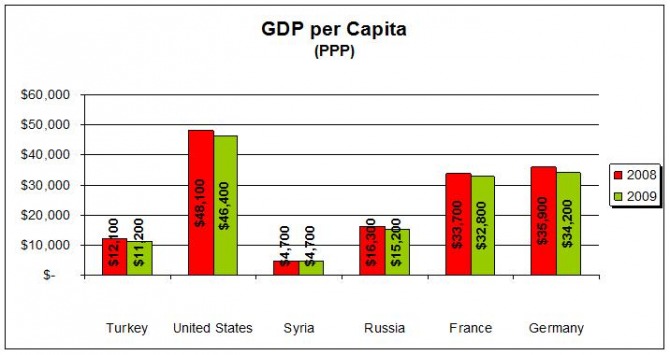Economic Status of Turkey
The third economic goal is high and sustained economic growth. Gross Domestic Product is defined as the growth of a country’s real income and is the total value of all final goods and services produced in a given time period, within a country’s borders. The real income of a country is measured by the sum of expenditures in the consumer, business, government, and foreign sectors (GDP = Consumption + Investment + Government Spending + Net EXports).
Turkey’s GDP for 2009 was $861.8 billion compared to $914.7 billion for 2008, which is a decrease of $52.9 billion. The United States also experienced a decrease in their GDP from 2008 to 2009 of $0.35 trillion. In 2009, Syria had a growth in their GDP of $2.2 billion, while Russia, Turkey’s import partner, had a decrease of $0.181 trillion. Turkey’s export partners, France and Germany both experienced a decrease in their GDP of $0.045 and $ 0.148 trillion, respectively. Real GDP changes only when output changes so a decrease in goods and services has taken place for Turkey, the United States, Russia, France and Germany.
The GDP per capita measures the average income of a person. Turkey had a slight change in GDP per capita from 2008 and 2009 was an average decrease of $900 per person. France also had the same decrease of $900 per person. The United States and Germany also had a decrease of $1,700 per person while, Syria’s GDP per capita remained the same.
Turkey’s Real GDP ranking is consistent with its per capita GDP ranking because both the Real GDP and the GDP per capita had a decrease from 2008 to 2009.
Turkey’s GDP for 2009 was $861.8 billion compared to $914.7 billion for 2008, which is a decrease of $52.9 billion. The United States also experienced a decrease in their GDP from 2008 to 2009 of $0.35 trillion. In 2009, Syria had a growth in their GDP of $2.2 billion, while Russia, Turkey’s import partner, had a decrease of $0.181 trillion. Turkey’s export partners, France and Germany both experienced a decrease in their GDP of $0.045 and $ 0.148 trillion, respectively. Real GDP changes only when output changes so a decrease in goods and services has taken place for Turkey, the United States, Russia, France and Germany.
The GDP per capita measures the average income of a person. Turkey had a slight change in GDP per capita from 2008 and 2009 was an average decrease of $900 per person. France also had the same decrease of $900 per person. The United States and Germany also had a decrease of $1,700 per person while, Syria’s GDP per capita remained the same.
Turkey’s Real GDP ranking is consistent with its per capita GDP ranking because both the Real GDP and the GDP per capita had a decrease from 2008 to 2009.

